Turkish armored vehicles ... In spite of everything
Altay became the first major combat a tankcreated in Turkey. After testing four prototypes, an order for 250 production vehicles is expected to be issued. The main armament of the tank - 120-mm smooth-bore gun L55
While many European countries have reduced their armored platform industry, and in some cases have completely abandoned their capacity to develop and manufacture such vehicles, Turkey is moving in the opposite direction.
Otokar and FNSS Savunma Sistemleri originally developed and manufactured armored combat vehicles (BBMs) only for the Turkish armed forces, but now both have become global players in a competitive export market, securing significant sales in Africa, Asia and the Middle East.
Company Otokar
For many years, Otokar was the largest manufacturer of wheeled armored vehicles in Turkey, but now has shifted its priorities somewhat and entered a more complex, but potentially profitable tracked field.
Otokar General Manager Serdar Gorgiu said: “We have been working in the defense industry for more than 28 years since our first tactical armored vehicle was manufactured for Turkey. Today, our machines are operated on five continents, in 30 countries, almost by 50 operators. Feedback and expectations of our users are our guide to expanding the range of products. Today, we manufacture 4x4 tactical wheeled vehicles and 800 kg armored vehicles to 60 tons. ”
In an August 2008 competition, Otokar won the grand prize of a $500 million, 78,5-month contract to develop the Altay Main Battle Tank (MBT), the most ambitious ground weapon system program ever undertaken by in Turkey. The contract provides for the design, development, testing and qualification of the Altay MBT in three stages.
The first phase began in January 2009 of the year and lasted about 18 months. It included the analysis of system requirements and the development of technical specifications. The second stage included the detailed design and manufacture of two experimental samples, which were made and first shown in November 2012 of the year.
An experimental model for testing the driving characteristics of the MTR (Mobility Test Rig) passed over 8000 km when conducting running tests on different types of terrain, and the second experimental sample for firing tests FTR (Firing Test Rig) shot over 1000 120-mm ammunition.
Following the FTR and MTR in the second half of 2014, two more experimental machines (PV1 and PV2) were made, after which acceptance tests began, which should be completed at the beginning of 2016 by troop tests.
The original contract with Otokar ended in mid-2015 and was therefore amended in the spring so that the entire project will end in early 2016. Preliminary negotiations between the Turkish Defense Industry Administration (SSM) and Otokar are ongoing and at the end of 2015 it is planned to sign a contract for serial production and issue an order for 250 Altay MBTs to the company, according to which the first Altay tank will be manufactured at the end of 2017.
In the middle of 2015, the only MBT produced in Europe (except Russia) was Krauss-Maffei Wegmann’s Leopard 2A7 tank and if additional export orders did not appear, by the end of this decade the Altay tank could become the only MBT produced in Europe . In this regard, significant export opportunities are opening up for Otokar.
The main weapon for the tank Altay full weight 68 tons is 120-mm smoothbore hand-loading gun L55, equipped with an ejection device for blowing the barrel bore, a thermoprotective barrel cover and a system for determining the curvature of the gun barrel.
Auxiliary armament consists of a 7,62-mm machine gun, paired with a gun. Another optional 7,62-mm machine gun is mounted on the roof of the turret on the left side, and the loader fires from it.
A remotely-controlled combat module (SDM), armed with an 12,7-mm machine gun, from which the commander or loader can fire, is also installed on the roof of the turret. The electric system of the turret and the gun is integrated with the fire control system (FCS), which includes stabilized commander and gunner aiming complexes.
Altay tank has a hydropneumatic suspension, which provides increased cross-country maneuverability.
The MTU EuroPowerPack power unit consists of a V-12 MTU MT 883 Ka 501 Common Rail diesel engine (develops 1500 hp power at 2700 rpm) connected to an Renk HSWL 295TM automatic transmission with five forward gears and three rear gears, and an efficient cooling systems.
According to Otokar, the power unit allows you to accelerate the Altay tank to a maximum speed of 65 km / h, the typical speed over rough terrain is 45 km / h and the cruising range for 450 km fuel.
The Tulpar BBM can be equipped with a variety of combat modules, including this uninhabited Otokar Mizrak RCT turret, armed with an 30-mm cannon and an 7,62-mm machine gun paired with it
The standard equipment of the Altay serial tank will include a laser warning system connected to groups of smoke grenade launchers, an air conditioning system, a target identification system, an information and control system and a communication system, a fire detection and fire extinguishing system, means to overcome a deep-water fording barrier, an auxiliary power plant and an all-perspective situational awareness system.
Otokar began in 2011 on its own initiative the development of armored infantry fighting vehicles Tulpar AIFV (armored infantry fighting vehicle). Factory testing of the first prototype began in January 2013, and the first public demonstration of the machine took place at IDEF in May 2013. At the beginning of 2015, during sea trials, the Tulpar AIFV traveled 3000 km both on paved roads and on rough terrain.
Serdar Gorgu continued: “In 2013, we added a new tracked vehicle to our range of wheeled vehicles. The new vehicle was created as an equal or superior competitor to new generation infantry fighting vehicles, which are being developed under similar programs of NATO countries; Tulpar is Otokar's own development. The car is named after the mythical winged horse that guarded the warriors in the Turkish epic Manas. The Tulpar infantry fighting vehicle meets the requirements of the 21st century, and its characteristics allow it to work in the same battle formations as MBT.
The first copy of the Tulpar was equipped with a remote-controlled Mizrak RCT (remote-controlled turret) turret of Otokar's own design, which has already passed fire tests on this chassis. The Mizrak turret is armed with an ATK Armament Systems selective-powered 30mm Mk44 cannon and a coaxial 7,62mm machine gun connected to a computerized FCS. The RCT tower can also accept other weapons of 20-40 mm calibers.
The commander and gunner installed stabilized day / night sighting systems, which also include a laser rangefinder, the commander has a panoramic sight.
The hull of the Tulpar machine is designed in such a way that it can receive other towers and the DBMS in accordance with customer requirements. The body of the car is all-welded from armored steel with the ability to install a set of hinged composite armor that increases the level of ballistic protection.
The hull design allows you to get a large number of options for performing various combat missions, ranging from basic armored personnel carrier to specialized options, such as sanitary, engineering, command and control station, mortar transporter and armament platform. In addition to the commander, gunner and driver in the first version of the BMP Tulpar is located nine paratroopers.
The power unit consists of a Scania diesel engine with a common DI 16 fuel line power 810 hp, connected to an SAPA SP-850 automatic transmission. The power unit allows you to reach a maximum speed on the highway over 70 km / h and have a power reserve of 600 km. Hydropneumatic suspension of the machine provides excellent cross-country maneuverability.
Otokar has now also moved to larger wheel platforms, including the Arma 8x8 and 6x6 family of machines, which are highly unified to reduce the cost of full service life.
The Arma machine in the 6x6 version was first shown in the 2010 year, later four experimental machines were made, followed by the 8xXNNXX version.
Otokar received at least two overseas contracts for Arma 6x6, and it is clear that one of the customers is Bahrain, which operates the Otokar Cobra 4x4 armored car fleet.
The total weight of the Arma depends on the level of ballistic protection and the installed weaponry, but for the 8x8 variant it is declared in 24 tons, while the 6x6 variant weighs 18,5 tons.
In both versions, an eight-cylinder diesel engine with a turbocharged horsepower 450 hp, coupled with an automatic transmission, is installed. The transmission of the 8x8 variant has seven forward and one reverse gears, and the transmission of the 6x6 variant has six forward and one reverse gears.
The company Otokar declare maximum speed 105 km / h and hydropneumatic suspension of both options.
Arma floating machine, in the water is driven by two water cannons installed in the stern of the hull.
On the Arma machine can be installed various weapons systems. The 8x8 variant has already been shown with the CT-CV twin-turret Belgian company CMI Defense, armed with an 105-mm rifled cannon, in which the automatic loader is located in the stern of the turret.
The newest Cobra II 4x4 wheeled armored vehicle developed by Otokar was first shown in the 2013 year. According to the company, the development of the Cobra II is completed and production can begin upon receipt of orders for this machine.
Armored Car Cobra II structurally significantly different from its predecessor. With a total mass of 12 tons, it has a larger volume and useful payload compared with the previous version, which allows you to perform a larger range of tasks. The key difference is that this armored car can be used for various tasks with minimal modification.
A special amphibious version was also developed and tested. In the same version of the armored personnel carrier are placed two crew members and eight paratroopers.
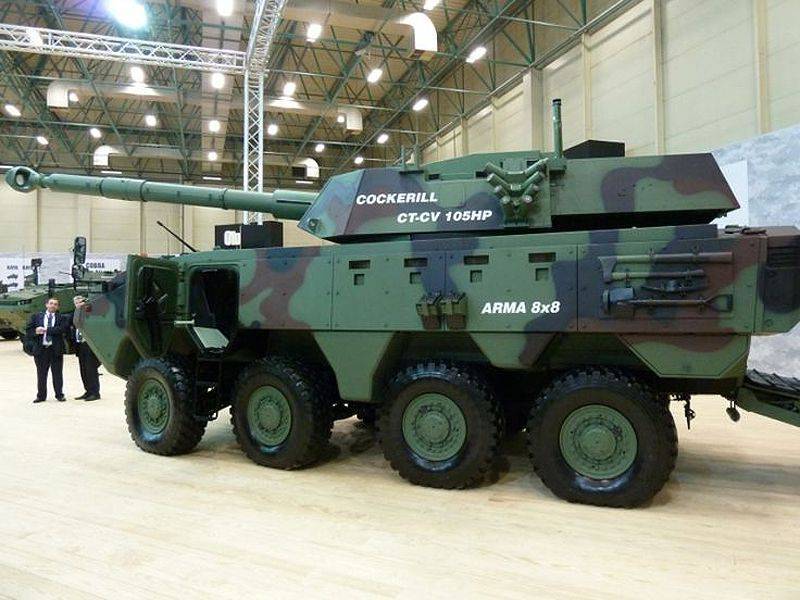
Arma 8x8 can be equipped with heavy towers, such as the CT-CV tower of the Belgian company CMI Defense, armed with an 105-mm rifled cannon with an automatic loader in the rear stern of the tower
It was made over 2500 Cobra 4x4 armored vehicles. This version is equipped with a protected combat module, armed with a 12,7-mm machine gun M2 HB
On the car Cobra II installed diesel engine with turbocharged water cooling power 281 hp or 360 hp, coupled with an automatic six-speed transmission and a two-speed transfer case.
Standard equipment includes a thermal camera installed in front, an air-conditioning system, a centralized tire pressure control system, anti-rim wheels and an anti-lock braking system.
The Cobra 4x4 light armored vehicle was originally developed by the company on its own initiative and soon entered service with the Turkish army. At the beginning of 2015, over 3000 machines were manufactured for the local and foreign markets. The production of this armored car for the needs of Turkey continues under a contract worth 113 million dollars, issued at the end of 2013.
The Cobra usually has an all-welded armored body with undercarriage components from the HMMWV (High-Mobility Multipurpose Wheeled Vehicle) all-purpose multi-purpose wheeled vehicle from AM General.
In the variant of the armored personnel carrier Cobra has a total mass of approximately 6,5 tons, it accommodates a crew of two people and seven people of the landing force. Many specialized options have been developed for this vehicle, for example, a reconnaissance, ambulance, anti-tank installation with roof-mounted ATGM launchers, a command post, a special operations vehicle, and a reconnaissance version with a sensor station for specific reconnaissance on a telescopic mast.
The BTR variant, designated Ural, was first shown in 2013; he is in service with rather Turkish security forces, and not the Turkish army.
The Ural armored vehicle has a total tonnage of 6,3, available in a ten-seat, three-door configuration and a nine-seat five-door configuration, including in both cases the driver and the commander.
Compared to the design of previous Otokar 4x4 4x4 vehicles, the exterior design of the Ural has a more streamlined shape. This is done in order to get a less threatening appearance of the vehicle for participation in peacekeeping and internal security operations. The machine has a diesel engine connected to a six-speed automatic transmission and a two-speed transfer case.
Otokar has manufactured a significant number of light armored vehicles of the Akrep family (Scorpio) in two versions: an armored personnel carrier and reconnaissance. Production of the Akrep armored car is completed, but it can be resumed upon receipt of export orders.
The company also produced a large number of lighter APCs based on the Rover Defender 4x4 chassis. Over 2500 armored patrol vehicles APV (Armored Patrol Vehicle) were manufactured for local and foreign markets. The largest customer was Iraq, which bought 600 vehicles. Although the production line is currently halted, there are plans to continue manufacturing the Defender in Turkey when Jaguar Land Rover closes its UK line at the end of 2015 and APV production can be brought on-demand.
FNSS expands its product range
Initially, the Turkish company FNSS Savunma Sistemleri was created for the production of armored vehicles of the company FMC Corporation. According to the results of competitive tests, in which the German Puma and the British Warrior BMP also took part, she was chosen by the Turkish army to fulfill the requirements of the Turkish infantry fighting vehicle (TIFV).
Initially, the company was owned by FMC (51%) and Turkish Nurol (49%), but today 51% is owned by Nurol and 49% by BAE Systems.
A total of 1698 TIFV vehicles were manufactured in four variants: infantry fighting vehicles (650 vehicles with a single-seat turret with a 25-mm selective cannon and a coaxial 7,62-mm machine gun), an advanced armored personnel carrier Advanced Armored Personnel Carrier (830 vehicles with 12,7 -mm machine gun in the turret), anti-tank installation (48 vehicles with TOW ATGM) and mortar transporter (170 vehicles with 81-mm mortar on a turntable).
Later, the second contract was obtained from the Turkish armed forces for another 551 AAPC car, which were delivered in 2001-2004 years.
The TIFV vehicle became the starting point for the development by FNSS Savunma Sistemleri of a complete family of vehicles for the export market, which was designated ACV (Armored Combat Vehicle).
At first, it was offered with a hp 300 or 350 diesel engine. depending on customer requirements. Currently, the machine has received a new designation ACV-15, the last figure indicates the total mass of the machine in tons.
The United Arab Emirates became the first overseas customer by purchasing the ACV-136 15 machines. Five options have been improved under the conditions of the Middle East through the installation of air conditioning and a new engine cooling system.
These options include: 52 ACV-ENG (ACV-Engineering Squad Vehicle), 8 evacuation vehicles (RARV) and 76 artillery support (ASV). The last option is divided into three: targeting, fire control center and control point.
Malaysia placed the second major contract for 211 ACV-15 machines, locally designated Adnan, in 10 configurations. Then came the second contract for 48 machines in seven specialized versions. The final assembly of the machine was carried out in Malaysia.
The ACV-15 family provides end-users with the ability to fine-tune the machine configuration to suit their needs, for example, installing various towers with appropriate weapon systems or round-the-clock surveillance equipment.
Haluk Buluchu, marketing director at FNSS Savunma Sisterleri, said that "in Turkey, we have gone from simple production of armored vehicles under license to design, development and production of complete vehicles, as well as major subsystems, such as towers."
The need of customers for a platform with a large volume and carrying capacity has led to the development of machines with an extended chassis Armored Combat Vehicle - Stretched (ACV-S).
Currently, the machine has received the designation ACV-19; as in the ACV-15 designation, the figure indicates the total mass of 19 tons. The level of unification with the ACV-15 variant is 90%, it has a similar layout, but an additional support roller is installed on each side, which made it possible to lengthen the machine body.
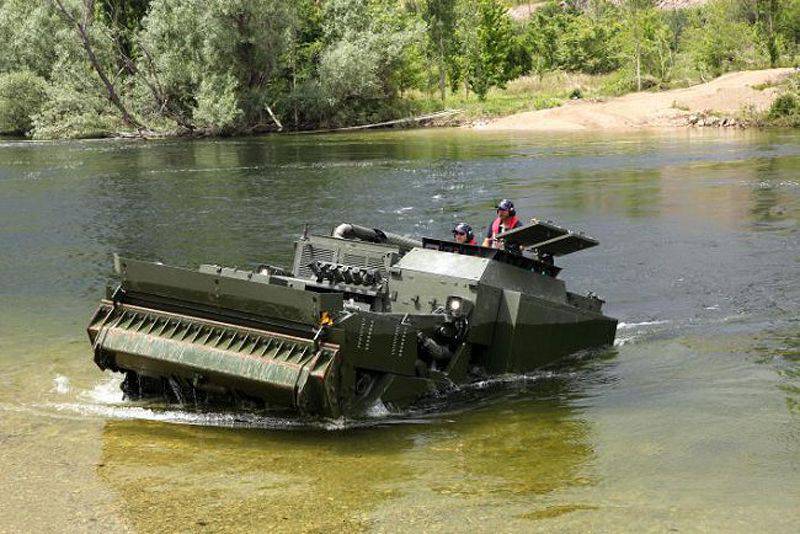
FACE's AACE comes ashore during testing in Turkey
AAAB Turkish self-propelled floating bridge used as ferry
Typical versions of the ACV-19 include a BMP with an installed single or double turret or a remote-controlled RCT turret with various weapon systems, a sanitary / medical evacuation option, a commander vehicle, an armament platform and a tracked supply vehicle. In the latter, the power unit and the habitable compartment are located in front, and the cargo platform with folding sides in the rear. Immediately behind the habitable compartment, a hydraulic crane with a telescopic boom is installed.
The first buyer of the ACV-19 option was Saudi Arabia, which received 10 vehicles in the configuration of the tactical command post Tactical Command Post Vehicle (TCPV).
The second buyer was Malaysia, which ordered eight ACV-19 machines, differing in the raised roof under which the rollback 120-mm mortar complex TDA 120 2RM was installed.
For the head company Aselsan, FNSS has developed, manufactured and supplied several pre-series complete tracked ACV-30 tracked vehicles (total weight 30 tons). The ACV-30 version is similar in appearance to the ACV-15 and ACV-19 variants, but has a wider and longer body.
The ACV-30 engine is equipped with an 600 horsepower engine, coupled with an automatic transmission, and as options for the ACV-15 and ACV-19. it is equipped with a set of mounted armor, installed in the front and on the sides.
The first option based on the ACV-30 chassis was the self-propelled anti-aircraft gun Korkut SPAAG, designed for the Turkish army, which currently does not have such a modern unit. Pass qualifying tests of this machine.
A typical Korkut battery will consist of one fire control station vehicle and three anti-aircraft guns. A fire control station with a surveillance radar and a day / night optoelectronic station transmits target data to SPAAG anti-aircraft guns, which capture targets to kill. The anti-aircraft installation is a chassis on which an RCT turret is installed, an armed twin 25-mm gun mount, as well as a tracking radar and an optoelectronic station for capturing targets in all weather conditions.
This version of the ACV-30 is completely floating and is driven in water by two water cannons located in the stern of the hull.
Korkut anti-aircraft gun
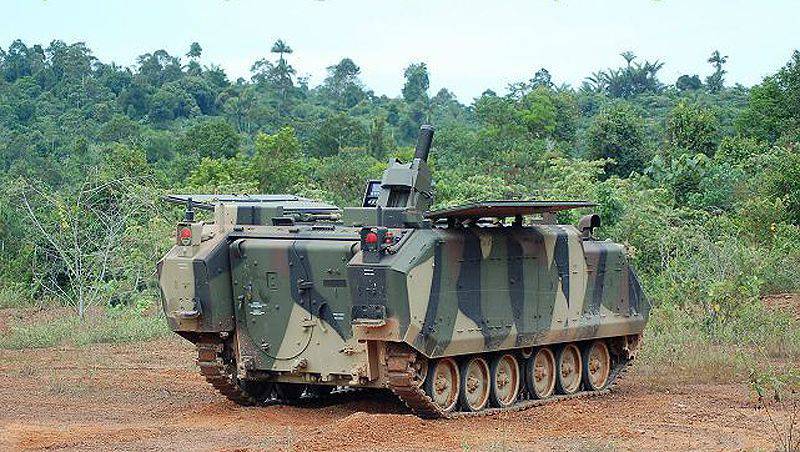
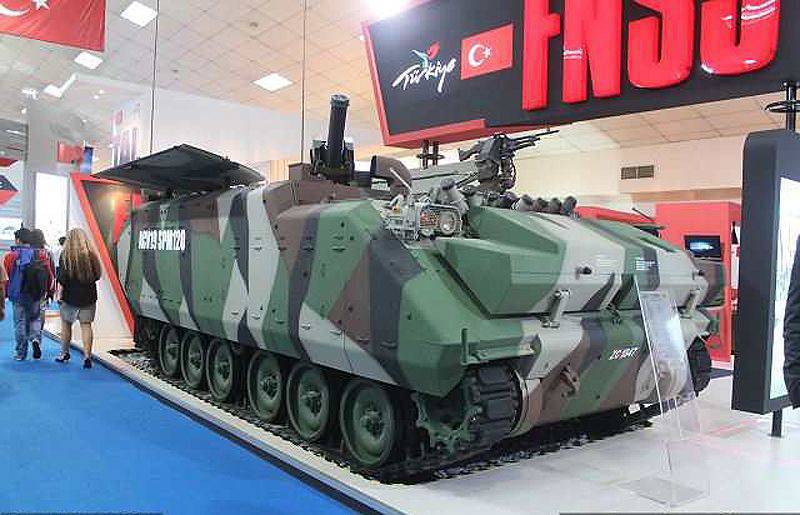
Malaysian ACV-19 machine in 120-mm mortar conveyor configuration
Cobra II is undergoing tests of water quality in one of the countries of the Middle East. On the water, the machine is driven by two propellers
Another variant of the ACV-30 is a short-range anti-aircraft missile launcher developed by Roketsan (rocket) and Aselsan (electronics and SLA) under a contract with the Turkish army; This option does not float. A radar on a telescopic mast is installed at the back of the platform.
Land-to-air missiles in launch canisters are lowered horizontally in the stowed position, but are raised to a vertical position before launch.
In the middle of 2013, the company showed a full-scale model of the Kaplan LAWC-T light armored Weapon Carrier-Tracked light tracked platform concept.
Light Armored Weapon Carrier-Tracked Light Tracked Platform
According to Mr. Buluchu, “This experimental machine has absorbed all our experience in designing and manufacturing tracked and wheeled armored vehicles. The crew seats in the front of the car, equipped with modern systems, are similar to the crew seats of the Pars armored vehicle. Rubber track tracks from Soucy International were installed, which made it possible to reduce noise, vibration and mass. ”
Currently, with the aim of expanding its market share, the company entered the extremely competitive field of wheeled vehicles with its Pars platform, which is now promoted as a family of 6xXNNXX and 6x8 machines with all-wheel steering.
The first customer of the Pars 8x8 option was Malaysia, which issued a local company, DEFTECH, a contract for 257 machines, designated AV8. The first batch of 14 machines was delivered at the end of 2014 of the year.
The first cars AV8 descended from the Turkish production line. AV8 enclosures are mass-produced in Turkey and Malaysia, and machines are currently being assembled in Malaysia. Final deliveries are scheduled for 2018 year.
All Malaysian cars have a “right-hand drive" configuration, equipped with air conditioning systems and RCB protection.
Malaysian Pars vehicles come in 12 variants: 30-mm turret, BMP (25-mm turret), BMP-BTR, anti-tank missile with laser-guided, control point, military observation point, ambulance, 120-mm mortar, evacuation, machine communications engineering workshop and RCB-intelligence.
With the exception of the machine in the configuration of the BMP with the LCT-30 tower from the South African company Denel Land Systems and the evacuation option, all Malaysian cars are floating.
FNSS Savunma Sistemleri develops engineering machines
In accordance with the contract concluded with the Turkish army, FNSS Savunma Sistemleri manufactured a total of 12 serial AACE (Amphibious Armored Combat Earthmover) Floating Combat Armored Digging Machines, the last of which was delivered in January 2013, although the company does not exclude the resumption of production upon receipt of additional orders.
AZMIM, which is the second development project of the Turkish Ministry of Defense in the field of ground vehicles after the FNSS project on the mobile assault bridge SYHK (Mobile Amphibious Assault Bridge), is a system designed to prepare river banks (slopes, soil hardness, surface irregularities, etc.) for entry into the water of floating vehicles during the forcing of rivers. In addition, it is the only armored floating bulldozer in service in the world.
The AZMIM or AACE tracked earthmoving machinery (Amphibious Armored Combat Earthmover) is used to train the river banks when they are forced. It can perform work such as site planning, rough alignment, digging, skidding and leveling.
One of the remarkable features of AACE is that this machine is floating, driven by two water cannons in the water and has a maximum speed of 8,6 km / h.
FNSS is responsible for the supply of all 12 machines, including a prototype for qualification and compliance tests.
Turkish AZMIM earthmoving machine
Although the Turkish AACE conceptually resembles the M9 Armored Combat Earthmover (ACE) earthmoving machine of the American army, but unlike it, the crew is two people, not one.
After winning the competition, the company received a contract worth 130 million dollars for the supply of the Turkish Army self-propelled floating bridges Armored Amphibious Assault Bridge (AAAB). The 52 system was delivered, including one training system consisting of 4 machines.
One AAAB axle is used as a MLC 21 (Military Load Class) ferry, two AAAB axles provide the MLC 70 (tracked vehicle), and three AAAB axles provide the MLC 100 (wheeled transport). When the AAAB 12 bridges are connected, a crossing with the carrying capacity of MLC 70 (tracked vehicles) and MLC 100 (wheeled vehicles) is formed, which makes it possible to cross rivers that are up to 150 meters wide.
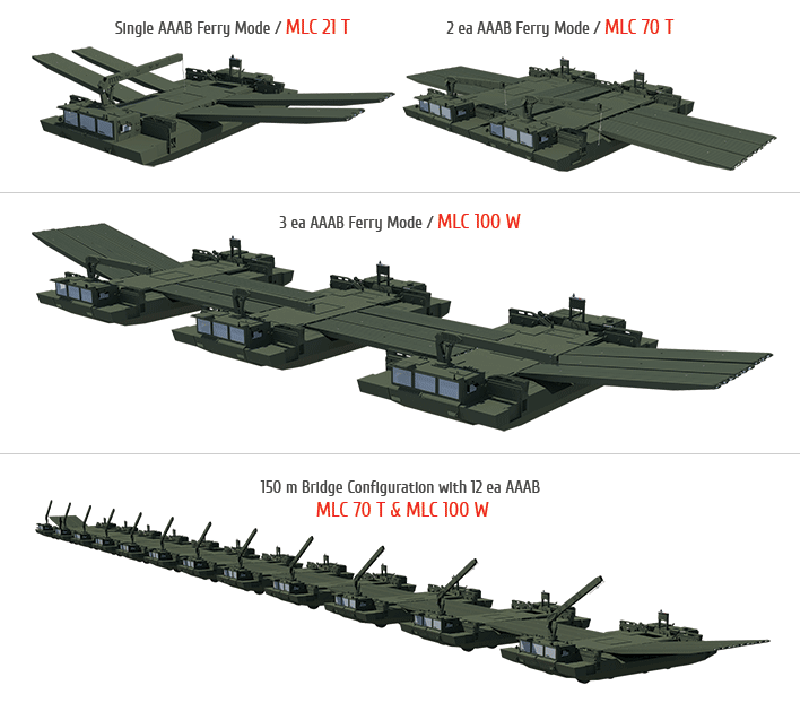
The AAAB bridge has a fully protected, air-conditioned cab in front, the suspension is the same as that of the Pars cars and all-wheel steering.
Comment
Turkey has created an industry capable of designing, developing and producing armored combat vehicles to meet the needs of the Turkish army. Turkey has been successful in overseas markets, but the support of the Muslim Brotherhood in Egypt has weakened its defense position.
Its new armored vehicles were created with a view to foreign markets, and in the case of light and medium armored vehicles, they are equipped with a variety of weapons systems in order to meet the requirements of the end user.
Turkey is also interested in joint ventures with foreign partners (one of them is Malaysia), which also makes offers on technology transfer.
Materials used:
www.otokar.com.tr
www.aselsan.com.tr
www.fnss.com.tr
www.wikipedia.org
en.wikipedia.org
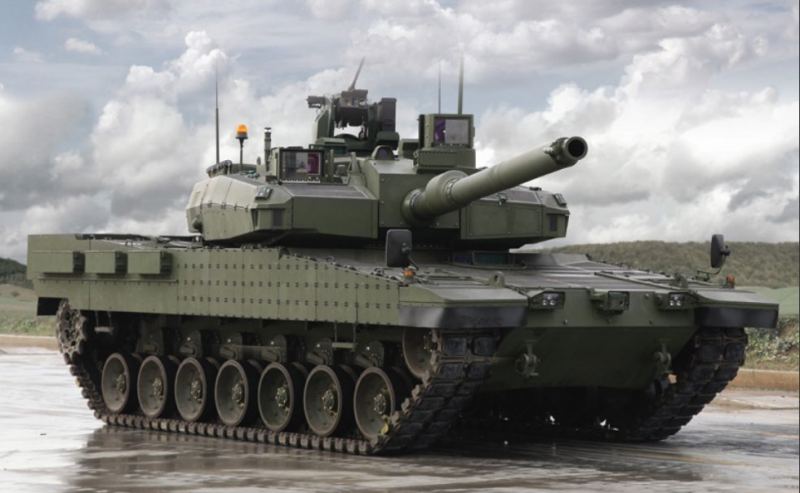
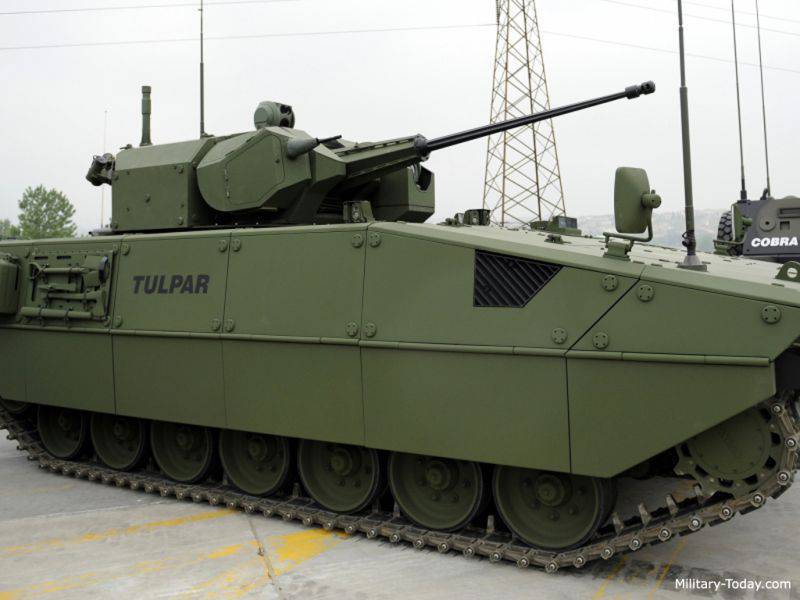
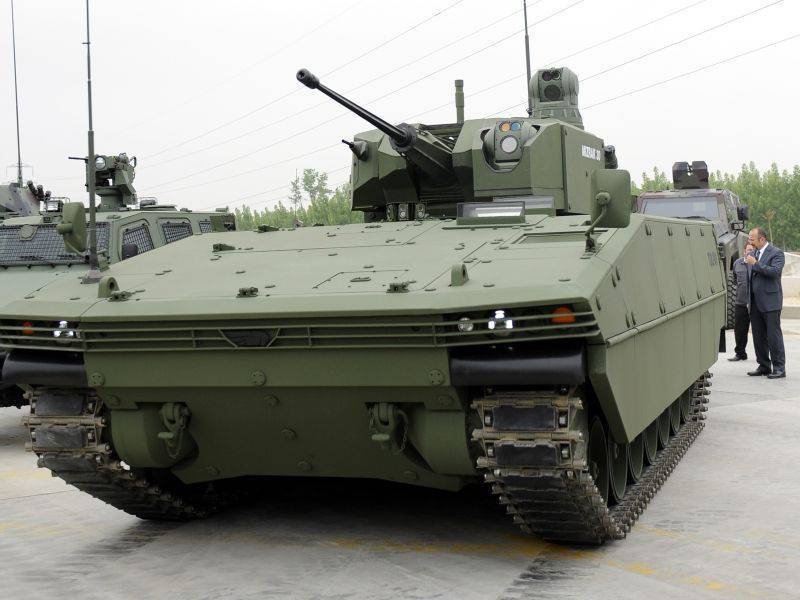
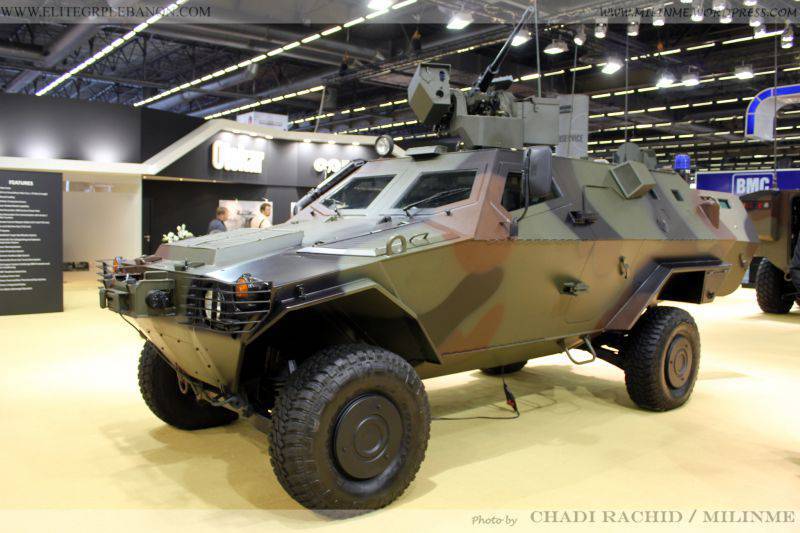
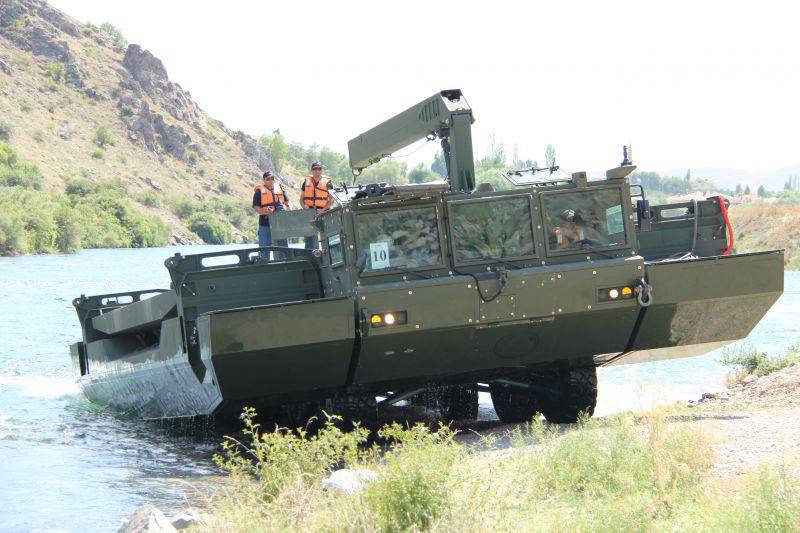
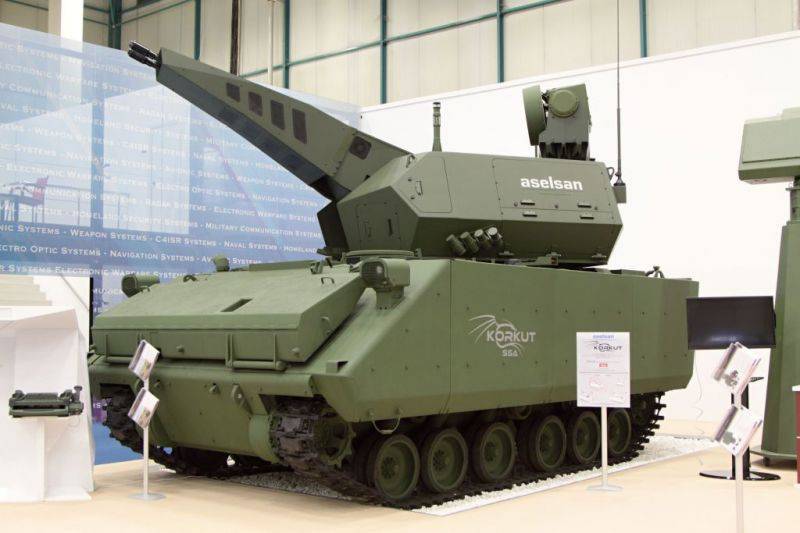
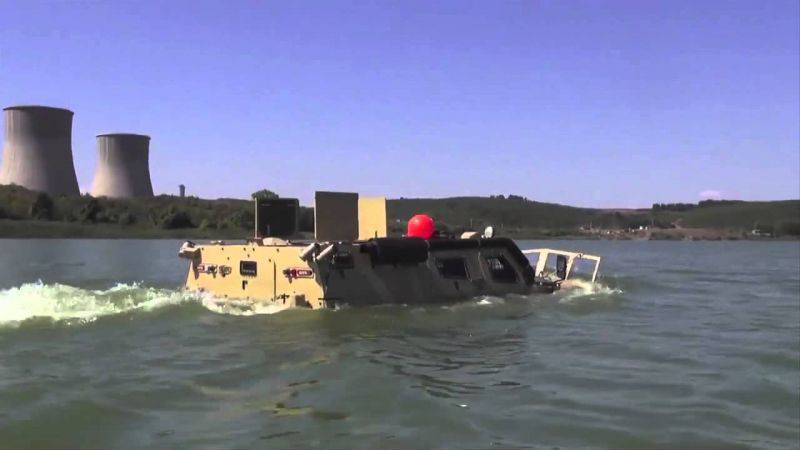
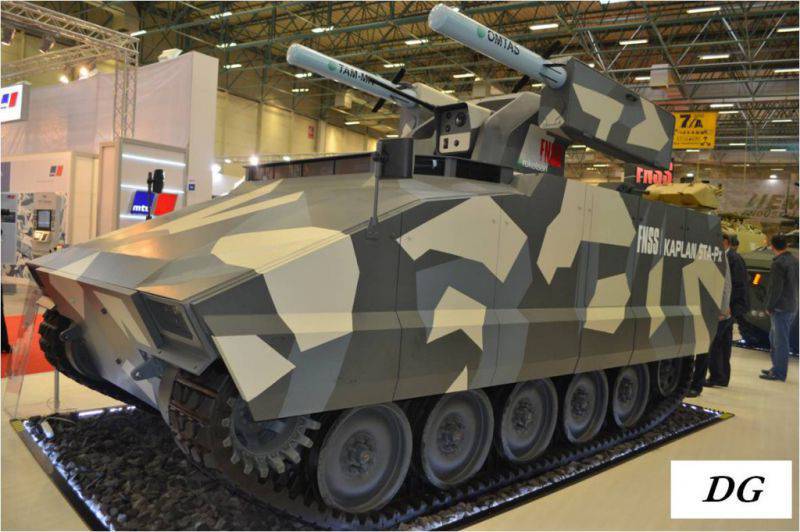
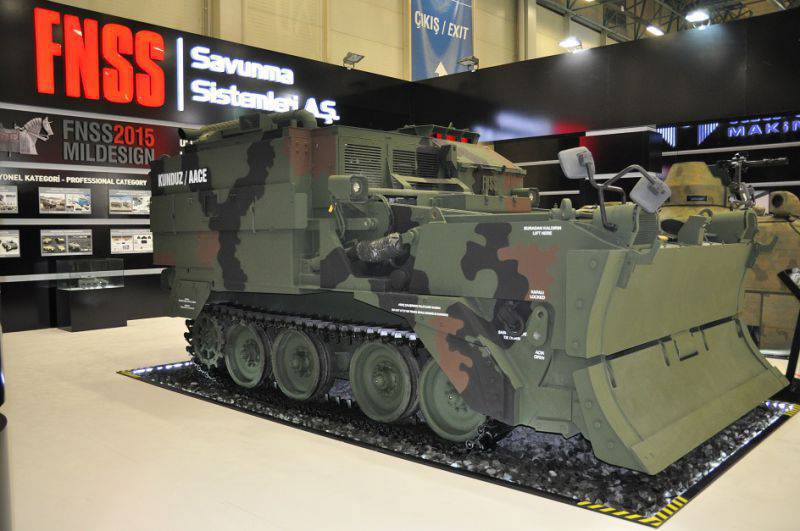
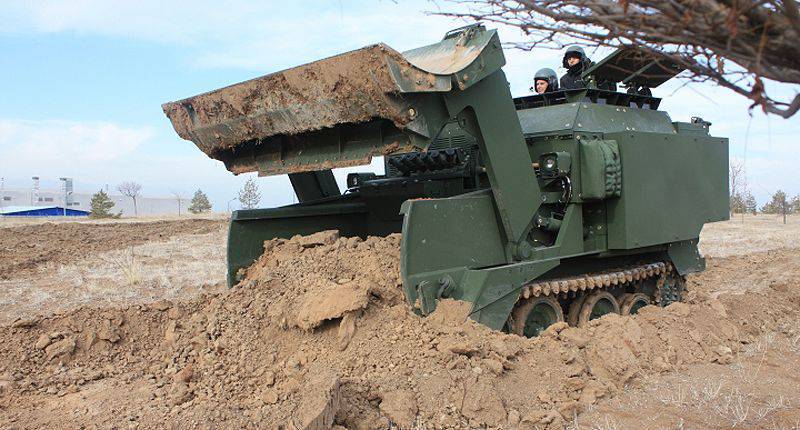
Information